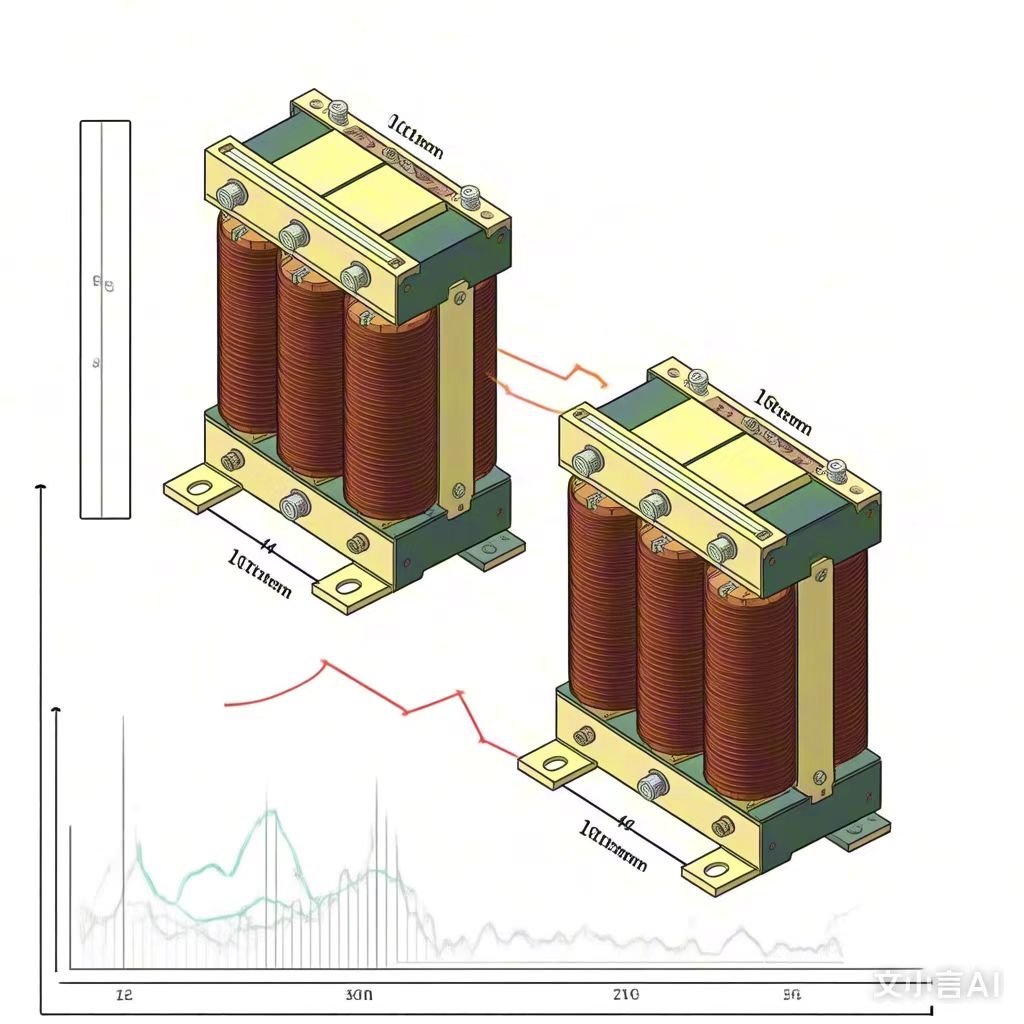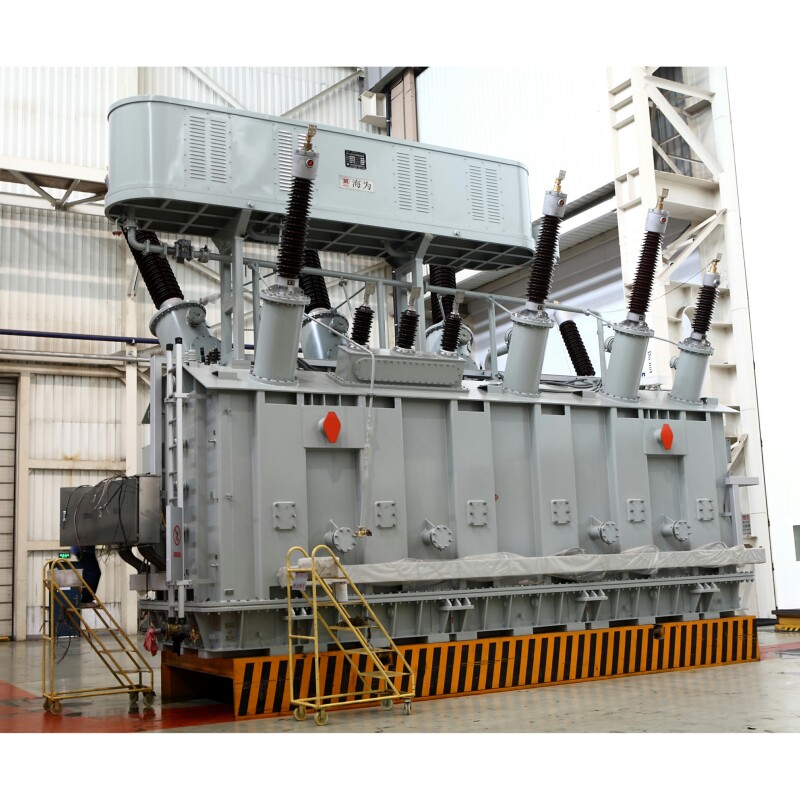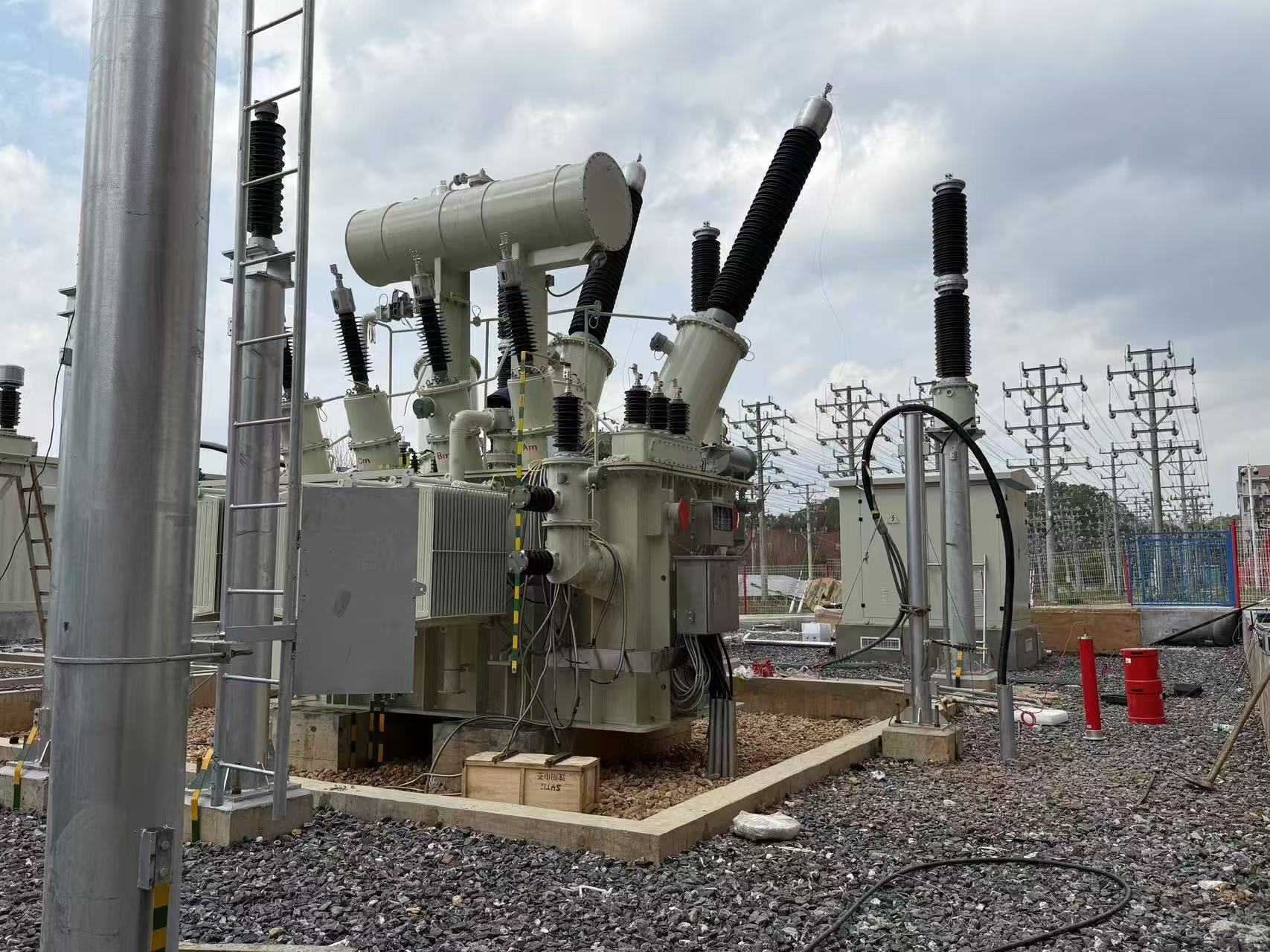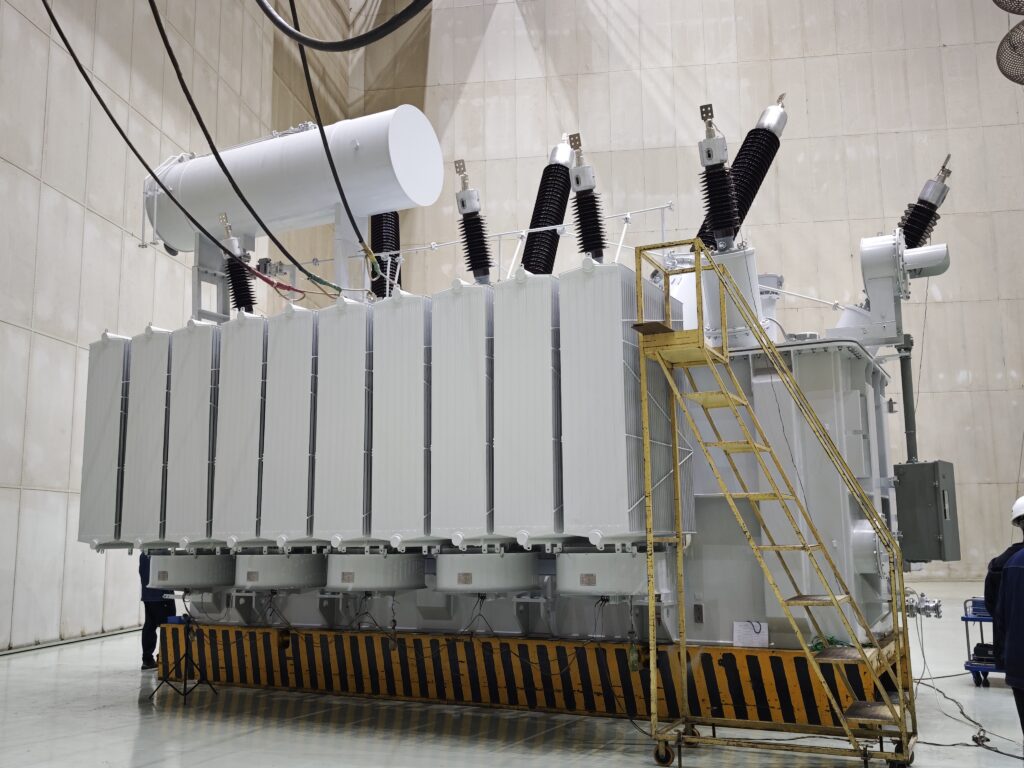Selecting the right transformer capacity is a critical aspect of ensuring the efficient and reliable operation of electrical systems. Whether you're designing a new installation or upgrading an existing one, choosing the right transformer size is essential for meeting power requirements without overloading the system or wasting energy. A transformer that is either too small or too large can lead to operational inefficiencies, increased costs, or even system failure.
This article will guide you through the process of selecting the right transformer capacity by considering various factors such as load requirements, voltage specifications, future expansion, and environmental conditions.
What is Transformer Capacity and Why is It Important?

Introduction: What Is Transformer Capacity?
Transformer capacity refers to the maximum amount of electrical power a transformer can handle under specific conditions, without sustaining damage or degradation in performance. It is typically expressed in volt-amperes (VA) or kilovolt-amperes (kVA), and in larger transformers, it can be in megavolt-amperes (MVA). The capacity of a transformer is directly related to the amount of load it can supply and plays a crucial role in ensuring that the electrical distribution network operates efficiently and safely.
Knowing the capacity of a transformer is critical for designing systems that meet energy demands while maintaining reliability. Whether you're upgrading an industrial facility, constructing a new building, or planning a grid expansion, understanding transformer capacity is an essential part of ensuring optimal energy distribution and preventing costly equipment failures.
What Is Transformer Capacity?
Transformer capacity refers to the transformer’s power rating, which is the maximum load it can safely handle without exceeding its thermal and electrical limits. It indicates the amount of electrical power the transformer can supply to the connected load. This value ensures that the transformer can operate within its design specifications, without overheating or being damaged by excessive electrical demand.
The power rating is calculated based on several key factors:
- Primary and secondary voltage levels: Voltage is a critical component in determining transformer capacity.
- Current-carrying capabilities of the windings: The transformer must be able to handle the current associated with its rated power.
- Core material and design: These determine the efficiency and energy losses during operation, impacting the capacity.
- Cooling mechanism: The type of cooling (such as natural air, forced air, or oil cooling) impacts how much power the transformer can handle.
In simpler terms, transformer capacity is the total amount of energy the transformer can safely transfer from the primary side (input) to the secondary side (output) under load conditions.
Why is Transformer Capacity Important?
Transformer capacity is crucial because it influences the performance, efficiency, and longevity of the electrical system. It directly impacts the following areas:
1. Safe and Reliable Power Distribution
The capacity of a transformer ensures that the connected load does not exceed the transformer’s rated power. Overloading a transformer can lead to overheating, insulation breakdown, and in extreme cases, catastrophic failure. Ensuring the transformer has adequate capacity for the expected load is essential to maintaining system stability and reliability.
2. Preventing Overload and System Damage
If a transformer’s capacity is exceeded, the system will experience overloading, which can cause a rise in temperature and increase the risk of damage. This can lead to system outages, equipment breakdowns, and potentially expensive repairs or replacements. Understanding and selecting the correct transformer capacity helps prevent such situations by ensuring the transformer operates within its safe limits.
3. Optimizing Energy Efficiency
Transformers that are too small for the load can cause voltage drops, increased losses, and poor power factor. On the other hand, oversized transformers are often inefficient because they may not be fully loaded, leading to unnecessary energy losses and wasted operational costs. Properly sizing transformers ensures optimal energy efficiency, reducing costs associated with power generation and consumption.
4. Facilitating Grid Expansion
For utility companies and industrial parks that experience significant load growth, selecting transformers with adequate capacity is key to accommodating future energy demands. This forward-thinking ensures that the transformers can handle increased capacity without requiring frequent replacements or upgrades, making long-term planning easier and more cost-effective.
5. Maintaining Compliance with Industry Standards
Electrical utilities and industrial facilities must adhere to safety and performance standards, which are often set by national and international regulatory bodies. These standards usually require transformers to meet specific capacity ratings to ensure safety and compliance with load distribution requirements. Properly sized transformers help meet these regulations, avoiding penalties or legal issues.
6. Improved Transformer Longevity
Transformers that operate within their rated capacity experience less strain and stress, contributing to longer operational lifespans. If a transformer is regularly overloaded, the wear on its components will increase, leading to frequent breakdowns and costly replacements. By selecting a transformer with the right capacity, users can ensure that the transformer functions optimally and is protected from premature aging.
How Is Transformer Capacity Calculated?
Transformer capacity is calculated using the formula:
[\text{Transformer Capacity (kVA)} = \frac{\text{Voltage (V)} \times \text{Current (A)}}{1000}]
This formula gives the power rating in kilovolt-amperes (kVA), where:
- Voltage (V) is the rated voltage applied to the transformer.
- Current (A) is the rated current that the transformer can carry safely.
For three-phase transformers, the formula is slightly modified to account for the phase difference:
[\text{Transformer Capacity (kVA)} = \frac{\sqrt{3} \times \text{Voltage (V)} \times \text{Current (A)}}{1000}]
Factors Affecting Transformer Capacity
Several factors influence transformer capacity, including:
1. Ambient Temperature and Cooling Mechanism
Transformers are rated for specific operating conditions, such as ambient temperature. A higher ambient temperature can reduce the capacity of the transformer, as it limits the ability of the cooling system to dissipate heat. Transformers with effective cooling systems, such as oil-cooled or forced-air systems, can handle larger loads more efficiently.
2. Power Factor of the Load
The power factor (PF) of the load determines how efficiently the transformer delivers power. A low power factor means that more power is required to supply the same amount of useful energy. In such cases, the transformer’s capacity may need to be higher to handle the inefficiency.
3. Voltage Regulation
Voltage regulation affects how well a transformer can maintain a stable voltage output under varying load conditions. A transformer’s capacity is influenced by how effectively it can regulate voltage while meeting load demands.
4. Load Type
The nature of the load, whether it is resistive, inductive, or capacitive, impacts the transformer’s capacity. Transformers must be rated to handle the type of load they will supply to avoid voltage fluctuations or overheating.
How Do Load Calculations Impact Transformer Capacity?
Introduction: The Importance of Load Calculations in Transformer Capacity
In electrical systems, the capacity of a transformer plays a critical role in ensuring efficient power distribution and system reliability. To optimize transformer performance and avoid costly failures, it is essential to properly calculate the load it is expected to handle. Load calculations determine the transformer’s load handling capacity, ensuring that it can meet the required power demands of the connected system without overheating or causing voltage drops.
Without accurate load calculations, transformers may be undersized, leading to overload conditions, or oversized, resulting in energy inefficiency. By calculating the expected load, businesses and utilities can ensure that the transformer operates at its full potential, maintaining safety, cost-effectiveness, and optimal energy usage.
How Do Load Calculations Impact Transformer Capacity?
Load calculations directly influence the selection and sizing of a transformer, impacting its capacity. The capacity of a transformer must be carefully aligned with the expected load demands to ensure the transformer can handle the maximum required power without excess strain. Here are several key ways in which load calculations affect transformer capacity:
1. Ensuring Proper Transformer Sizing
One of the most important impacts of load calculations is determining the correct transformer size. If the transformer is too small for the load, it will operate under constant overload conditions, leading to issues such as overheating, insulation damage, and ultimately transformer failure. Conversely, if the transformer is too large for the load, it will run inefficiently, leading to higher operational costs and energy waste. Proper load calculations ensure that transformers are neither oversized nor undersized for the given electrical demand.
2. Maximizing Efficiency and Reducing Energy Losses
Underloaded transformers (those with capacity far exceeding the actual load) waste energy due to core losses and magnetizing currents, which result in lower energy efficiency. This inefficiency leads to higher operational costs and wasted electricity. Load calculations enable engineers to choose a transformer that meets the required capacity without over-designing the system, leading to optimized efficiency and cost savings over time.
3. Managing Voltage Regulation and Power Quality
Accurate load calculations help maintain voltage stability. A transformer’s ability to regulate voltage depends on its load. Excessive loads can cause voltage dips and fluctuations, impacting the power quality delivered to sensitive equipment or processes. On the other hand, transformers that are properly sized for the load can maintain a more consistent voltage level, ensuring that the electrical system operates smoothly and efficiently.
4. Preventing Overload and Transformer Failures
Without accurate load calculations, transformers can experience excessive strain when the connected load exceeds the rated capacity. This overload condition can lead to damage to the transformer’s windings, insulation, and core, resulting in reduced lifespan and higher repair or replacement costs. Accurate load calculations ensure that transformers are appropriately rated for the expected power demand, preventing transformer burnout, short circuits, and system downtime.
5. Planning for Future Load Growth
In industrial parks, commercial complexes, or utility systems, load calculations should not only account for the current demand but also anticipate future load growth. When planning for future expansions, considering anticipated increases in load (due to additional equipment, more users, or higher consumption) is crucial for ensuring that the transformer remains capable of handling new demands. This foresight prevents frequent upgrades, reduces costs, and ensures continued service reliability as the system evolves.
6. Optimizing Transformer Utilization
Correct load calculations ensure that the transformer operates at an optimal loading condition. Transformers are designed to perform best when they are loaded to a certain percentage of their capacity. If a transformer operates at a load level significantly higher than its capacity, it may not only risk overheating but also be more susceptible to failure. If it operates well below its capacity, it may result in underutilization of the transformer, leading to inefficiency in energy distribution. By carefully calculating the load and selecting the appropriate transformer capacity, businesses ensure that the transformer performs at its best, with minimal energy losses and operational costs.
Key Parameters in Load Calculations
Several key parameters affect load calculations and, consequently, transformer capacity:
1. Voltage Requirements
The primary voltage required to operate the transformer and the secondary voltage needed for the load will dictate the transformer’s power rating. Transformers step voltage up or down, and the correct voltage ratio must be maintained to ensure proper power delivery.
2. Current (Amperage)
The current that a transformer needs to handle is directly linked to its load capacity. As the load increases, so does the current demand. Properly sizing the transformer ensures it can handle both the expected load and the maximum expected current without overheating.
3. Power Factor (PF)
The power factor is a measure of how effectively electrical power is being used. A low power factor means that more power is being consumed to do the same amount of useful work, leading to inefficient operation. Load calculations must factor in the power factor, as it affects the apparent power the transformer must handle.
[\text{Apparent Power (kVA)} = \frac{\text{Real Power (kW)}}{\text{Power Factor}}]
4. Load Type
The type of load (whether resistive, inductive, or capacitive) affects how a transformer handles electrical power. For example, inductive loads (e.g., motors) draw a lagging current, while capacitive loads may require leading current. Load calculations need to take these differences into account to ensure that the transformer can supply power in the appropriate manner for each load type.
How to Perform Load Calculations for Transformer Capacity
Load calculations typically involve the following steps:
1. Determine the Total Load
Add up the total power demand of all connected equipment and devices. This will give you the total wattage (kW) required by the transformer.
2. Consider the Power Factor
Multiply the total load by the power factor (if it is less than 1), to calculate the apparent power required in kVA.
[\text{Apparent Power (kVA)} = \frac{\text{Total Load (kW)}}{\text{Power Factor}}]
3. Account for Voltage Levels
Ensure that the transformer is sized according to the voltage levels it will need to operate at. This includes both primary and secondary voltage requirements.
4. Add a Safety Margin
It is a good practice to add a safety margin (typically 10-20%) to account for unexpected increases in load. This ensures that the transformer is capable of handling transient or peak demands without overloading.
What Role Does Voltage Rating Play in Transformer Capacity Selection?

Introduction: The Critical Role of Voltage Rating in Transformer Capacity Selection
When selecting a transformer, one of the most important parameters to consider is its voltage rating. Voltage ratings directly influence the capacity and efficiency of a transformer in a power distribution system. A transformer is designed to step up or step down the voltage to meet the needs of connected equipment, and an incorrect voltage rating can lead to issues like inefficiency, overheating, or equipment damage.
What is Voltage Rating and Why Does It Matter?
The voltage rating of a transformer refers to the maximum voltage level the transformer can handle on both its primary (input) and secondary (output) sides. The voltage rating defines the transformer’s ability to safely operate without exceeding its design limits.
Voltage ratings are typically expressed in kilovolts (kV) and are crucial for determining:
- Step-up or Step-down Capability: A transformer can either increase (step-up) or decrease (step-down) voltage, depending on the system requirements.
- Power Handling: Voltage impacts the overall power handling of the transformer, directly influencing the selection of transformer capacity.
- Safety and System Compatibility: Choosing a transformer with the correct voltage rating ensures compatibility with the overall power system, minimizing the risks of overloading or malfunction.
How Does Voltage Rating Impact Transformer Capacity Selection?
Voltage rating plays a vital role in determining the capacity and performance of a transformer. The relationship between the voltage rating and the capacity is closely intertwined. Here are several key factors where voltage rating influences transformer capacity selection:
1. Voltage and Power Calculation
A transformer’s voltage rating helps determine the apparent power (measured in kVA) it can handle. The capacity of the transformer depends on the input and output voltage levels, as they affect the current passing through the transformer. The basic formula for transformer capacity is:
[S = \frac{V{1} \times I{1}}{1000}]
Where:
- S is the transformer capacity in kVA.
- V₁ is the primary voltage in volts.
- I₁ is the primary current in amperes.
For step-up transformers, the voltage rating on the secondary side (higher voltage) determines how much power can be transmitted over long distances. Conversely, a step-down transformer reduces the voltage to lower levels suitable for local distribution or consumer use.
2. Matching Voltage to System Requirements
The primary role of a transformer is to adjust voltage levels to match system requirements. Choosing the right voltage rating ensures compatibility with the distribution network and load demands. If the voltage rating of the transformer does not align with the system’s needs, you might face:
- Overvoltage or Undervoltage Conditions: Overvoltage can damage sensitive equipment, while undervoltage can cause inefficient operation or system instability.
- Mismatch of Equipment Voltage Needs: The equipment or devices connected to the transformer must be rated for the output voltage; otherwise, the transformer will fail to meet the required power supply specifications.
3. Impedance and Voltage Regulation
A transformer’s voltage rating also affects its impedance, which impacts the voltage regulation. Impedance in transformers creates a voltage drop under load conditions. When there is a high voltage difference between the primary and secondary windings, the voltage regulation becomes a critical factor in maintaining the desired voltage levels at the secondary side. An optimal voltage rating will ensure that the transformer can handle expected load conditions while minimizing voltage fluctuations.
4. Selecting the Right Transformer for Load Demands
When selecting a transformer, the voltage rating helps in determining the correct size to meet the load demands of the application. For example, transformers for industrial or commercial applications may require higher voltage ratings to supply power over long distances, while those used in residential areas may only require lower voltage ratings. Accurate voltage ratings help ensure that the transformer can supply the correct amount of power at the required voltage level.
5. System Efficiency and Loss Minimization
The voltage rating also impacts the efficiency of a transformer. If the voltage is mismatched to the system requirements, the transformer will work inefficiently, which can result in increased losses and higher operational costs. Higher voltage ratings, such as those used in high-voltage transmission systems, allow for reduced transmission losses by stepping up the voltage for long-distance transmission. Lower voltage transformers are better suited for local distribution, where power loss is minimized at short distances.
6. Temperature and Cooling Considerations
The higher the voltage rating, the greater the demand for cooling and temperature management. Transformers with higher voltage ratings tend to have more windings, and therefore, require more effective cooling systems to manage heat generation during operation. Ensuring that the transformer’s voltage rating aligns with the expected load will also help in selecting the correct cooling system and materials to prevent overheating and ensure long-term reliability.
How Voltage Rating Affects Transformer Design
Transformers are designed with specific voltage ratings in mind. These ratings determine critical design parameters such as:
- Core Material Selection: The core material must be capable of handling the voltage levels without saturation or significant losses. Higher voltage ratings often require specialized core materials to ensure efficient operation.
- Insulation Requirements: High-voltage transformers require advanced insulation systems to prevent breakdowns. Insulation materials and designs must be selected to ensure that the transformer can withstand the electrical stresses imposed by high voltage levels.
- Size and Weight: As voltage increases, transformers often become larger and heavier due to the need for larger windings and more robust insulation. Selecting the correct voltage rating ensures that the transformer is adequately sized for both electrical and physical constraints.
How Do Power Factor and Load Type Affect Capacity Selection?
Introduction: Understanding the Link Between Power Factor, Load Type, and Transformer Capacity
When selecting a transformer for an industrial, commercial, or residential application, it's essential to consider how the power factor and load type affect the transformer’s capacity. These two factors play a crucial role in ensuring that the transformer can meet the electrical demands of the system efficiently and without overloading. If the transformer’s capacity isn’t correctly matched with these parameters, it can lead to issues such as overheating, energy wastage, and system inefficiency.
In this article, we’ll explore how power factor and load type influence transformer capacity selection and how you can optimize transformer choice for your power system’s specific needs.
What is Power Factor and Why Does it Matter?
The power factor (PF) is a measure of how efficiently electrical power is being used in a system. It is defined as the ratio of real power (kW) to apparent power (kVA). The formula for power factor is:
[\text{Power Factor (PF)} = \frac{\text{Real Power (kW)}}{\text{Apparent Power (kVA)}}]
The power factor value ranges from 0 to 1, with 1 representing perfect efficiency (all power is used effectively). In most practical scenarios, the power factor will be less than 1, indicating that some power is lost or wasted, typically due to inductive loads.
- Unity Power Factor (PF = 1): All the power supplied is used to perform useful work.
- Lagging Power Factor (PF < 1): Caused by inductive loads, such as motors, which result in a delay between the voltage and current.
- Leading Power Factor (PF < 1): Caused by capacitive loads, which also delay the power flow but in the opposite direction.
A low power factor means that more apparent power (kVA) is needed to supply the same amount of real power (kW), which can stress the transformer and lead to higher operational costs. Conversely, a high power factor minimizes the demand on the transformer, making it more efficient.
How Power Factor Affects Transformer Capacity Selection
Since the transformer is responsible for supplying the apparent power (kVA) required by the load, the power factor plays a significant role in determining the transformer’s capacity. For example:
-
Low Power Factor (Lagging): When a system has a low power factor (e.g., due to heavy inductive loads like motors or large machinery), the transformer must be sized to handle a higher apparent power (kVA) to supply the same amount of real power (kW). This results in larger transformer capacity, more losses, and lower system efficiency. Therefore, transformers for systems with a low power factor need to have a higher capacity to meet the extra demands created by reactive power.
-
High Power Factor (Leading or Unity): A higher power factor means that the power delivered to the load is used more efficiently, requiring less apparent power to deliver the same amount of real power. As a result, the transformer can be sized smaller (lower kVA), reducing capital investment, installation cost, and energy losses.
The Role of Load Type in Transformer Capacity Selection
In addition to power factor, the load type plays a significant role in determining transformer capacity. The load type refers to the characteristics of the electrical devices or systems that the transformer is powering. There are several load types, each with specific demands on the transformer:
1. Resistive Loads
- Characteristics: Resistive loads, such as heating elements or incandescent light bulbs, draw power directly from the supply with minimal phase shift between voltage and current. These loads result in a unity power factor (PF = 1), meaning that all the power is used efficiently for the work.
- Impact on Transformer Capacity: For purely resistive loads, the transformer capacity can be accurately matched to the real power demand (in kW). There is no need for over-sizing, and energy losses are minimal.
2. Inductive Loads
- Characteristics: Inductive loads, such as motors, transformers, and solenoids, cause the current to lag behind the voltage. This results in a lagging power factor. The lag between voltage and current increases the apparent power required, leading to higher transformer capacity needs.
- Impact on Transformer Capacity: Systems with a significant portion of inductive load will require transformers with a larger capacity (kVA) to handle the extra reactive power. This is especially important in industrial applications where large motors and machinery are present.
3. Capacitive Loads
- Characteristics: Capacitive loads, such as capacitor banks and certain electronic equipment, cause the current to lead the voltage. These loads can improve the power factor if used correctly, offsetting the inductive effects in a system.
- Impact on Transformer Capacity: While the transformer may not need to be as oversized for capacitive loads, excessive capacitive load can lead to problems like overvoltage or resonance issues in the power system. Capacitive loads must be carefully managed to avoid these adverse effects.
4. Non-Linear Loads
- Characteristics: Non-linear loads, such as variable frequency drives (VFDs), rectifiers, and computers, cause harmonics in the electrical system, leading to distorted current waveforms. These loads typically result in both harmonic distortion and poor power factor.
- Impact on Transformer Capacity: Non-linear loads demand a higher capacity transformer to handle the additional harmonic currents and prevent overheating or damage to the transformer. Specialized transformers, such as harmonic-filtering transformers, may be required in these situations.
How to Optimize Transformer Capacity for Power Factor and Load Type
To optimize transformer capacity selection, it’s important to consider both the power factor and the load type. Here’s a step-by-step approach:
-
Calculate Real Power (kW) and Apparent Power (kVA):
Determine the real power requirements of the system and the expected power factor. From there, calculate the required apparent power (kVA):
[kVA = \frac{kW}{\text{Power Factor (PF)}}]
For systems with low power factor, consider power factor correction techniques (e.g., adding capacitor banks) to improve efficiency and reduce transformer size. -
Understand Load Characteristics:
Assess the predominant load type (resistive, inductive, capacitive, or non-linear) to determine the additional reactive power the transformer needs to handle. -
Ensure Transformer Sizing Accounts for Peak Loads:
Choose a transformer with sufficient capacity to handle both average and peak load conditions. Inductive or non-linear loads may cause momentary surges, so the transformer should be able to handle these variations without overloading. -
Consider Power Factor Correction Equipment:
In systems with low power factor, it’s beneficial to include power factor correction devices, such as capacitor banks or synchronous condensers, to reduce the reactive power demand. This can help reduce the overall transformer size and improve system efficiency.
Why Should Future Expansion Be Considered When Selecting Transformer Capacity?

Introduction: The Importance of Planning for Future Growth
When selecting a transformer for any electrical distribution system, it is crucial not only to consider the current load requirements but also to account for future expansion. Failing to plan for future growth can result in costly upgrades, unnecessary downtime, or system failures that could have been avoided with proper foresight. Transformers that are undersized for future needs can place unnecessary strain on the system, while oversized transformers may lead to higher initial costs and energy inefficiencies.
In this article, we’ll discuss why considering future expansion is essential when selecting transformer capacity and how to ensure that your electrical infrastructure remains reliable and cost-effective as your needs grow.
The Risk of Underestimating Future Load Growth
Electrical systems are rarely static, especially in environments like industrial plants, commercial buildings, and data centers, where power demand can increase due to business growth, technological upgrades, or new equipment. If a transformer is sized only to handle current demand, you risk running into several problems:
- Overloading and Equipment Failure: If the transformer is not rated to handle future increases in load, it may fail prematurely, leading to expensive repairs or the need for replacement sooner than anticipated.
- Disruptions in Power Supply: Insufficient transformer capacity can cause power outages or voltage instability as the system struggles to meet demand.
- Increased Downtime: Replacing or upgrading a transformer to meet future demand after it fails can result in costly downtime, halting operations, and productivity loss.
A transformer that is undersized for future needs could result in overloading, system instability, or complete failure, leading to significant operational disruptions.
Benefits of Considering Future Expansion When Selecting Transformer Capacity
Planning for future expansion ensures that your electrical system remains efficient, cost-effective, and reliable over time. Here are the key benefits:
1. Avoiding Early Upgrades and Redundancy
Selecting a transformer that has the capacity to handle future growth can help you avoid unnecessary upgrades. When future demand is considered during the design phase, you can eliminate the need for mid-life replacements or expansion projects. Instead of purchasing and installing new transformers as soon as capacity is exceeded, your system will be able to accommodate higher loads without major changes.
- Example: If a manufacturing plant anticipates doubling its production in the next 5–10 years, a transformer sized for future load can be installed at the outset, preventing the need for expensive replacements down the line.
2. Long-Term Cost Efficiency
A transformer sized for future expansion can provide long-term savings by spreading out the capital expenditure. Over-sizing a transformer initially may cost more upfront, but it can save money by avoiding multiple replacements or upgrades later. In addition, transformers that are built to accommodate growth may be more energy-efficient in the long run, as they will not be operating at or near full capacity for the entire lifespan.
- Example: A business expecting to add more equipment in the future can install a transformer that can support additional loads without requiring modifications or an extra unit, thus saving on operational and maintenance costs over time.
3. Ensuring System Stability and Reliability
A transformer that’s ready for future expansion will help ensure that the system operates smoothly even as load increases. With ample capacity, your transformer can maintain stable voltage levels and reduce the risk of faults as demand grows. This reduces the chances of operational issues that could be triggered by system instability, such as power interruptions or equipment failure.
- Example: In a hospital, electrical loads are critical and must be continuous. A transformer sized to handle future load increases ensures that power remains uninterrupted, even as more equipment and systems are added.
4. Flexibility for Future Technological Advancements
As technology advances, so do the power requirements of modern equipment. For instance, automation systems, high-efficiency motors, and data centers often require significant power. A transformer capable of handling future technological changes will prevent you from constantly reassessing your electrical infrastructure needs.
- Example: Data centers, where power demands grow exponentially with the increasing use of servers and cloud computing, benefit from transformers that can handle higher capacity as their needs grow.
How to Plan for Future Expansion When Selecting Transformer Capacity
Here are several key steps to consider when selecting a transformer with future expansion in mind:
1. Assess Current and Projected Load Growth
Begin by determining the current load requirements and understanding how your system is likely to grow in the coming years. Consider factors such as:
- Business growth: Will your operations increase in size or scope?
- Technological upgrades: Will new equipment or technologies be added to the system?
- Regulatory changes: Are there upcoming regulations or environmental factors that may influence energy consumption?
Work with engineers and system planners to estimate the future electrical load, taking into account both expected growth and potential changes in energy demand due to new technologies or expansions.
2. Factor in Safety Margins
When selecting a transformer, it’s advisable to add a safety margin to accommodate for unforeseen increases in demand. A typical margin is around 20% to 30% of the expected maximum load. This allows the transformer to continue operating effectively even during peak demand periods or sudden spikes in usage.
3. Choose a Scalable Solution
Select a transformer that offers scalability or modularity. Some transformers can be upgraded or parallelized with additional units as load demands increase. This allows for easier expansion without needing a complete overhaul of the system.
- Example: Some manufacturers provide modular transformer solutions, where additional units can be added over time as the load grows, rather than replacing the entire system.
4. Incorporate Energy Efficiency Considerations
As demand grows, transformer efficiency becomes even more important. Ensure that the selected transformer has high efficiency ratings (low losses) and advanced features such as load tap changers that can optimize performance as load changes. Transformers with high efficiency also minimize operational costs over their lifespan.
5. Evaluate the Transformer’s Load Flexibility
Consider the load types that the transformer will handle in the future. A transformer that can handle a variety of load types (resistive, inductive, capacitive, and non-linear) will be better prepared for any changes in system demand.
How Do Environmental and Installation Conditions Affect Transformer Capacity?

Introduction: The Impact of Environmental and Installation Conditions on Transformer Capacity
When selecting a transformer for an electrical distribution system, it's essential to consider not only the electrical requirements but also the environmental and installation conditions under which the transformer will operate. These external factors can significantly influence the transformer's capacity, efficiency, and lifetime. Ignoring these conditions can lead to underrated transformer performance, premature failure, or reduced operational efficiency.
Transformers are designed to operate optimally within specific environmental and installation conditions. If these conditions deviate from the expected parameters, the transformer may experience overheating, loss of efficiency, or unreliable performance. This can affect your system's reliability, increase maintenance costs, and shorten the transformer's lifespan.
In this article, we’ll explore how environmental factors like temperature, humidity, altitude, and installation conditions such as ventilation and space influence transformer capacity and overall performance.
How Temperature Affects Transformer Capacity
One of the most significant environmental factors influencing transformer performance is temperature. A transformer's temperature rating dictates the maximum operating temperature at which it can function efficiently without risk of damage. Understanding this is crucial because temperature has a direct impact on the load carrying capacity of the transformer.
- Overheating: When temperatures rise, the transformer’s internal components—such as the windings, insulation, and core—are subjected to thermal stresses. High temperatures can cause insulation breakdown, leading to short circuits and transformer failure.
- Cooling Efficiency: Transformers rely on cooling systems like air cooling (fans), oil circulation, or natural convection. Ambient temperature affects the efficiency of these cooling mechanisms. Higher environmental temperatures mean the cooling system has to work harder to dissipate heat, which may reduce the transformer's overall capacity.
In environments with extreme heat (e.g., desert areas or industrial zones), transformers may need to be oversized to accommodate the additional cooling demand. In cold environments, transformers may be able to operate at higher load capacities, but there are still risks related to freezing of coolant fluids or increased vibration due to temperature extremes.
Claim:
Temperature significantly affects transformer capacity, as high ambient temperatures can reduce the operational capacity and lifespan of a transformer.True
High ambient temperatures increase the likelihood of overheating and strain the transformer's cooling systems, reducing its efficiency and lifespan.
The Role of Humidity and Moisture on Transformer Performance
Humidity and moisture levels in the environment can also have a profound impact on transformer performance and capacity. Transformers, particularly dry-type transformers, are sensitive to excessive moisture, which can lead to:
- Corrosion of metal parts: Excessive humidity can cause rusting and corrosion of the transformer’s metal components, such as bushings, tank materials, and electrical contacts, which weakens the overall structure and compromises its operation.
- Insulation degradation: Moisture ingress into the insulation system (such as paper or resin) reduces its dielectric strength, potentially causing short-circuiting or electrical breakdown.
- Increased electrical losses: High humidity levels can cause surface leakage currents, leading to additional heat generation and reduced efficiency.
To mitigate these issues, transformers installed in areas with high humidity or frequent rainfall should be equipped with waterproof enclosures, dehumidifiers, or moisture-proof insulation to prevent corrosion and moisture buildup.
The Influence of Altitude on Transformer Capacity
The altitude at which a transformer is installed can affect both its cooling and electrical performance. At higher altitudes, the air density decreases, which in turn affects the transformer’s ability to dissipate heat. This results in:
- Reduced cooling efficiency: Lower air density means less heat dissipation via convection. In regions of high altitude (such as mountainous areas), transformers may require additional cooling systems or may need to be oversized to handle the higher heat retention.
- Insulation considerations: Transformers at high altitudes are exposed to lower atmospheric pressure, which can influence the dielectric strength of air and lead to electric breakdown under certain conditions. To combat this, transformers installed at higher altitudes are often built with specialized insulation to withstand lower air pressure.
For installations at altitudes exceeding 1000 meters (3281 feet), manufacturers may recommend adjusting the transformer's capacity by derating it by approximately 1% for every 100 meters of elevation. This means that transformers in high-altitude areas must be selected with care to ensure they meet the required cooling performance and electrical safety.
Claim:
Altitude affects transformer capacity, and transformers installed at higher elevations may require more efficient cooling and additional insulation to maintain capacity.True
Higher altitudes have lower air density, reducing the natural cooling ability of the environment, and may require transformers to be derated for safe and reliable operation.
Space and Installation Conditions Impact Transformer Performance
The physical installation environment also plays a crucial role in how a transformer performs. Several factors contribute to this, including:
1. Ventilation and Airflow
Proper ventilation is necessary to ensure that the transformer’s cooling system works efficiently. Transformers that are installed in enclosed spaces or poorly ventilated areas will struggle to dissipate heat, leading to:
- Overheating: Inadequate airflow around the transformer can cause internal temperatures to rise, which stresses the internal components and may lead to premature failure.
- Reduced capacity: A transformer that operates in a poorly ventilated area will often need to be oversized to handle the extra heat load, increasing both installation and operational costs.
Transformers installed outdoors or in well-ventilated rooms will perform much better, and their capacity will not be limited by cooling inefficiency.
2. Space for Expansion and Accessibility
Consideration for space around the transformer is also vital. Adequate clearances are necessary for both maintenance and future upgrades. If the transformer is to accommodate future growth (in terms of load), the installation site should allow easy access for future expansions or adjustments.
- Example: An industrial plant that plans to expand should have space for additional transformers, ensuring the system can handle increased demand without compromising on operational reliability.
3. Proximity to External Influences
Transformers should not be located in areas that expose them to external hazards such as chemical vapors, high levels of dust, or corrosive substances. These can degrade the transformer’s casing, electrical components, and insulation, ultimately affecting its capacity and reliability. It's important to place transformers in protected areas to reduce the risk of damage.
Conclusion
Selecting the right transformer capacity involves a careful assessment of several critical factors that ensure the transformer meets both current and future power needs without overloading or being inefficient.
-
Load Calculations: Start by calculating the total load that the transformer needs to support. This includes peak demand and ensures that the transformer can handle the highest load without issues.
-
Voltage Ratings: Ensure that the transformer’s primary and secondary voltage ratings match the voltage levels of the power supply and the equipment being powered.
-
Power Factor and Load Type: Take into account the power factor (which affects the real power usage) and the type of load (whether resistive or inductive). Inductive loads typically require higher capacity due to the nature of their power consumption.
-
Future Expansion: Consider potential growth in the load demand. Selecting a transformer with a slightly higher capacity than your current needs can help accommodate future expansion without the need for an early replacement.
-
Environmental and Installation Conditions: The transformer should be selected to handle environmental factors like temperature, humidity, and altitude. Transformers operating in harsher conditions (e.g., high-altitude locations or extreme temperatures) may require additional cooling mechanisms or derating.
By carefully assessing the total load requirements, voltage specifications, and the environmental factors, you can choose a transformer with the appropriate capacity that will provide efficient, reliable, and safe power distribution for your application.
In summary, selecting the right transformer capacity requires a holistic approach that includes load forecasting, voltage compatibility, consideration of future needs, and operational conditions. By addressing these key factors, you can avoid under-sizing or over-sizing the transformer, ensuring long-term reliability, cost-effectiveness, and efficient system performance.
FAQ
Q1: How do you calculate the right transformer capacity?
A1: To calculate the right transformer capacity, you need to know the load requirements, voltage levels, and the type of system (single-phase or three-phase). The basic formula for three-phase systems is:
Transformer Capacity (kVA) = (Voltage × Current × √3) / 1000
For single-phase systems, use:
Transformer Capacity (kVA) = (Voltage × Current) / 1000.
Additionally, consider factors like power factor and future load growth when selecting capacity.
Q2: What factors should be considered when selecting transformer capacity?
A2: Key factors include the load type (resistive, inductive, or capacitive), load demand, voltage levels (primary and secondary), power factor, and any potential future expansion. Also, consider ambient temperature, transformer efficiency, and the possibility of harmonics in the system. Ensuring the transformer is neither under- nor oversized is essential for energy efficiency and longevity.
Q3: How do load factors influence transformer capacity selection?
A3: Load factors determine the maximum load the transformer will handle under normal operating conditions. If the load factor is high, the transformer needs a higher capacity to avoid overheating or underperformance. A typical load factor is around 0.8 to 1.0, but for highly variable loads, selecting a larger capacity transformer may be advisable to ensure reliable performance.
Q4: What is the role of voltage in transformer capacity selection?
A4: Voltage plays a critical role in determining the transformer’s capacity because it directly affects the amount of current needed to supply the load. Higher voltage systems generally require transformers with lower current ratings, which can reduce the physical size of the transformer. Ensuring the transformer’s voltage rating matches the system's voltage is crucial for safe and efficient operation.
Q5: How does the power factor affect transformer sizing?
A5: The power factor represents the efficiency of power usage in a system. A lower power factor means more apparent power is required to supply the same real power to the load. When the power factor is low, a transformer with a higher kVA rating is needed to ensure sufficient power delivery. It’s important to account for the power factor when determining the correct transformer size.
References
"How to Properly Select Transformer Capacity for Your System" - https://www.transformertech.com/transformer-capacity-selection - Transformer Tech
"The Importance of Load Calculation in Transformer Sizing" - https://www.powermag.com/transformer-sizing-guide - Power Magazine
"Guide to Transformer Sizing: How to Calculate Capacity" - https://www.electrical4u.com/transformer-sizing - Electrical4U
"Factors to Consider When Choosing Transformer Capacity" - https://www.sciencedirect.com/topics/engineering/transformer-sizing - ScienceDirect
"Selecting the Right Transformer Capacity for Industrial Applications" - https://www.researchgate.net/transformer-capacity-industrial-applications - ResearchGate
"How to Calculate and Choose the Right Transformer Size" - https://www.smartgridnews.com/choosing-right-transformer-size - Smart Grid News
"Selecting Transformer Capacity for Optimal Performance" - https://www.energycentral.com/c/ee/selecting-transformer-capacity - Energy Central
"Understanding the Role of Power Factor in Transformer Sizing" - https://www.powergrid.com/transformer-sizing-power-factor - PowerGrid



